From the field to the bench
-
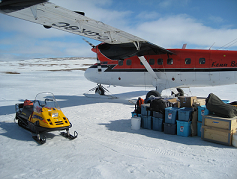
Welcome to the Environmental Chemistry Research Blog! Below are brief summaries of recent publications or notes from field campaigns carried out by graduate students in our department. The purpose of this blog is to showcase the kinds of research being undertaken here and how it helps improve our understanding of the environment.
Our division works on a wide array of topics, using different techniques, in very different settings. These brief blog posts provide a look into the diverse world of environmental chemistry at the University of Toronto.
Graduate students who want to send in a blog post should contact Sarah Kavassalis.
-

Photo Credit: Angela Hong Uintah Basin Wintertime Ozone Study 2014
Author: Angela HongI am currently stationed at our field site at Horsepool, Utah. The landscape is barren and desolate: there are some low lying shrubs that peek out from the snow, but in 360 degrees, the land is flat and without features. On days with good visibility, we can sometimes see the Uintah Mountains to the north and maybe the Wasatch Mountains to the west. Millions of years ago, this land was covered by a sea. Over geological time, the marine deposits turned into the oil and gas fields that are present in the basin today. In fact, if you look closely, you can see the storage and condensate tanks, pump jacks, and drill heads scattered throughout the basin. This is a region of intense oil and gas activity.
The Uintah basin is also a place that experiences severe wintertime pollution, with ozone concentrations that exceed U.S. national air quality standards. It may seem like an unlikely candidate for bad air quality as we often associate smog with densely populated urban centres in the summertime, but emerging cases of wintertime ozone pollution such as what has been observed in Uintah County are beginning to change how we think about the type of chemistry that controls ozone pollution.
Along with colleagues from Canadian and American universities and government research institutions, I am participating in the Uintah Basin Wintertime Ozone Study (UBWOS) 2014, a field campaign led by the National Oceanic Atmospheric Administration that is aimed at better understanding the unique chemistry responsible for severe ozone pollution. We hypothesize that the snow plays an integral role in the recycling of radical precursors that are necessary for ozone formation. For example, reservoirs of reactive nitrogen oxides can undergo reactions in or at the snowpack and be transported into the overlying boundary layer where they can participate in VOC oxidation, which in turn, forms ozone. To study this intriguing phenomenon, we have built and deployed a small sampling tower to sample air for reactive nitrogen oxides (NO, NO2, and NOy) and ozone within the interstitial air of the snowpack and the overlying atmosphere. Our dataset of concentrations of NO,NO2, NOy, and O3 at each discrete height will be used along with the other chemical and meteorological measurements to infer the role of snow-mediated chemistry in wintertime ozone pollution.
-
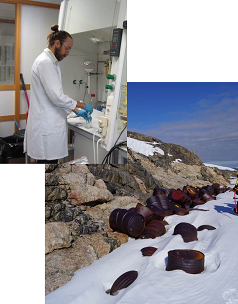
Photo Credit: Dave McLagan Local source contributions of brominated and fluorinated persistent organic pollutants from an Antarctic research station
Author: David McLaganPolybrominated diphenyl ethers (PBDEs) and perfluorinated compounds (PFCs) are both commonly used in consumer products for purposes such as fire-risk reduction, water-proofing, or their “non-stick” properties (Teflon), and fall under a category of environmental contaminants known as persistent organic pollutants (POPs). The United Nations Environmental Program defines POPs as “chemical substances that persist in the environment, bio-accumulate through the food web, and pose a risk of causing adverse effects to human health and the environment”. Thus it is imperative to control and monitor such contaminants in the environment, especially remote and highly susceptible ecosystems such as Antarctica. Like the vast majority of human settlements, polar research stations require many consumer products in their operation and consequently themselves are a potential source of POPs. This project aimed to investigate Casey Station, an Australian Antarctica research station, as a source of PBDEs and PFCs to the local environment by analyzing samples of indoor dust, treated wastewater, soil, sediments, moss, lichen, fish and invertebrates in and around the station. Key to the project was differentiating contaminants emitted from the station itself and those conveyed to the region from more heavily populated source regions such as Australia, Africa and South America. This was examined by testing the aforementioned sampling media at varying distances from the station. Results from the study were indicative of the station being a source of both PBDEs and PFCs. This demonstrates that anthropogenic research activities in Polar Regions are impacting their local environment, which are often more susceptible to the effects of contamination due to their otherwise pristine conditions.
-
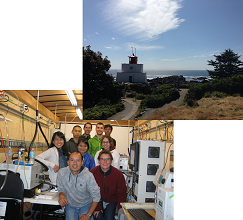
Photo Credit: Jacquie Yakobi Sea Spray and Cloud Formation on the West Coast
Author: Jacquie YakobiAerosol particles are emitted into the atmosphere by both anthropogenic and biogenic sources (such as sea spray). Once in the atmosphere, these particles are able to both directly scatter incoming solar radiation and function as cloud condensation nuclei (CCN). CCN are key in the formation of low-lying warm clouds that are primarily composed of liquid droplets. Although the oceans cover 70% of the earth’s surface, the cause of the oceans’ large cloud coverage is highly uncertain; it could either be due to the presence of sea spray aerosol in the atmosphere, or to anthropogenic aerosol that mixes downwards in the atmosphere from above the marine boundary layer. In order to explore this question, myself and several other graduate students and post docs from U of T, the University of British Columbia, and the University of Denver travelled to a small town called Ucluelet, which is located on the west coast of British Columbia in August 2013. Here, we (1) investigated the abilities of sea spray aerosol particles to form clouds using a Cloud Condensation Nuclei Counter (CCNC) and (2) determined the aerosols’ chemical composition using ion chromatography. Based on the preliminary results it seems that sea spray aerosol may be partially responsible for the high degree of cloud coverage that has been observed above bodies large of water such as the Pacific Ocean. My time in Ucluelet was one of the most rewarding opportunities that I’ve ever experienced. Not only did it allow me to spend one month in a town that people from all over the world wish to visit, but it allowed me to learn about environmental chemistry in a hands-on manner. It also gave me the chance to collaborate with a variety of scientists of different backgrounds
-
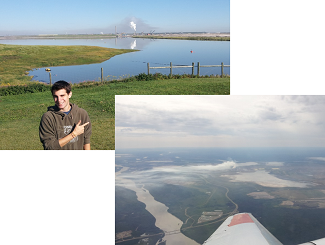
Photo Credit: Greg Wentworth Oil Sands Intensive Monitoring Study
Author: Greg WentworthThe Athabasca Oil Sands Region (AOSR) contains the largest known reserve of crude bitumen in the world and covers 141,000 square kilometres (greater than the size of New Brunswick, Nova Scotia, and P.E.I. combined). Increasing development has raised many environmental concerns and is a frequently debated topic in Canada. This past summer, myself and three other graduate students from U of T Environmental Chemistry participated in a field campaign to study air quality in the AOSR. The study was spearheaded by Environment Canada and involved over 90 individuals from government, academia, and industry. The main objectives were to: (1) quantify and speciate emissions, (2) validate emission inventories, (3) assess pollutant transport and transformation, and (4) validate satellite data. To accomplish this, advanced instrumentation was set up at two ground sites and on an aircraft (a picture taken from the aircraft is on the right). I was stationed at one of the ground sites and was in charge of running the Ambient Ion Monitor-Ion Chromatograph (AIM-IC) which can simultaneously measure water-soluble gases and particles. Measurements were taken for six weeks and the preliminary results are very interesting! The chance to collaborate with so many experts from other institutions was extremely eye-opening and valuable. It was a great opportunity to learn about the environment in a very hands on manner, even if it meant living in Fort McMurray for six weeks!
-

Photo Credit: Ran Zhao Formation of aqueous-phase alpha-hydroxyhydroperoxides (alpha-HHP): potential atmospheric impacts
Author: Ran ZhaoAldehydes and hydrogen peroxides are common chemical compounds in the atmosphere. However, these compounds could actually react with each other in water to form organic peroxides, a class of toxic compounds. In fact in the atmosphere, water in clouds, fog, and particles may facilitate this reaction. The published article carefully characterized this reaction and estimate its potential importance in the atmosphere. In the lab, we mixed hydrogen peroxide with a variety of atmospherically relevant aldehydes and carefully measured how many organic peroxides were formed. Based on our experimental results, we also performed simple model simulations to estimate the importance of this reaction. As a result, we found that this chemistry may not be very important in cloud water, but may be quite important in wet atmospheric particles. So how do these reactions affect us? Our study shows that this chemical reaction between aldehydes and hydrogen peroxide can make more organic peroxides that increase the toxicity of these little particles in the atmosphere.
-

Photo Credit: Nadine Borduas Gas Phase Oxidation of Monoethanolamine (MEA) with OH Radical and Ozone: Kinetics, Products and Particles
Author: Nadine BorduasIn this paper, we looked at the atmospheric chemistry of monoethanolamine (MEA), because MEA is an important molecule in a pilot-plant stage technology called carbon capture and storage (CCS). CCS uses MEA to capture carbon dioxide in the chimney and the captured carbon dioxide can then be sent underground to be stored. So CCS allows industries to produce energy without emitting carbon dioxide, a prevalent greenhouse gas. But what if MEA leaked out to the atmosphere from the industrial plants that use CCS? How would MEA affect the environment around these industries? To try to answer these questions, we studied the reaction of MEA in the gas phase with oxidants commonly found in the atmosphere, like the OH radical and ozone. We did our reactions in a big plastic bag connected to different instruments to calculate how fast MEA reacts with oxidants. We determined that these reactions happen very quickly and so MEA will not last long in the atmosphere. However, we did detect lots of products containing nitrogen. Among these products, the most concerning for human health is isocyanic acid (HNCO) which is quite toxic. We also detected particles with lots of nitrogen, which means that MEA is capable of forming particles in the atmosphere. In all, we learned that MEA reacts quickly with oxidants, can form toxic products, creates particles and is both stinky and viscous!
-
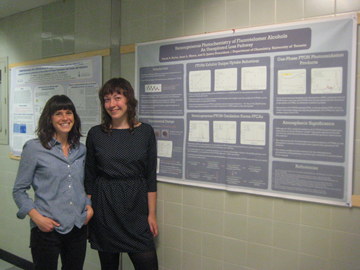
Sarah Styler and Anne Myers Heterogeneous Photoxidation of Fluorotelomer Alcohols: A New Source of Aerosol-Phase Perfluorinated Carboxylic Acids
Author: Sarah StylerThis research focuses on sunlight-induced chemical reactions happening on atmospheric surfaces, including the particulate matter that contributes to air pollution in urban environments. One of the great things about the environmental chemistry group at U of T is the opportunity it provides to work with and learn from friends who have different areas of expertise. In this project, I had the luck of working with my friend and colleague Anne Myers to investigate a new surficial pathway for the photooxidation of fluorotelomer alcohols, which are a group of fluorine-containing compounds used in the industrial manufacture of paints and water-resistant coatings. Using a variety of analytical techniques, we found that these compounds stick efficiently to real desert sand and volcanic ash samples and are oxidized there by solar radiation to yield perfluorinated carboxylic acids, which are toxic and persistent chemicals that have been detected in a broad range of urban and remote ecosystems. Our results suggest that the light-induced oxidation of fluorotelomer alcohols on particulate matter may be a previously unrecognized source of perfluorinated carboxylic acids in urban areas, and that the long-range transport and subsequent deposition of this particulate matter may contribute to perfluorinated carboxylic acid contamination in remote regions.
-

Perry Mitchell High Affinity Sorption Domains in Soil Are Blocked by Polar Soil Organic Matter Components
Author: Perry MitchellSoils are complex mixtures of minerals (which come from rocks) and organic matter which is derived from living organisms such as plants and microbes. Soils are very complicated systems that vary greatly, but now advanced instruments allow us to study soil structure at the molecular level. In this study, we characterized the components in five soils using nuclear magnetic resonance. This technique involves spinning a small soil sample inside a giant magnet, zapping it with radio waves and then seeing how it responds, which after some fancy math provides us with information about the contents. In another experiment, we mixed soils with three organic compounds which are commonly found in wastewater and contaminate soil through irrigation. This included two common herbicides (atrazine and diuron) as well as bisphenol A, a controversial ingredient in many plastics. These experiments allowed us to investigate how strongly these contaminants stick to the soils. We hypothesized that the soil organic matter is actually composed of different layers, with the outermost layer having a high affinity for water. After we treated the five soils with acid to remove these structures, we noticed that the three contaminants bound more strongly than before in all cases. This led us to conclude that the outermost layer blocks the contaminants from reaching other binding sites at the interior of soil organic matter where they would stick more strongly. We hope that this study will help scientists better understand how soil components are arranged at the molecular scale.


